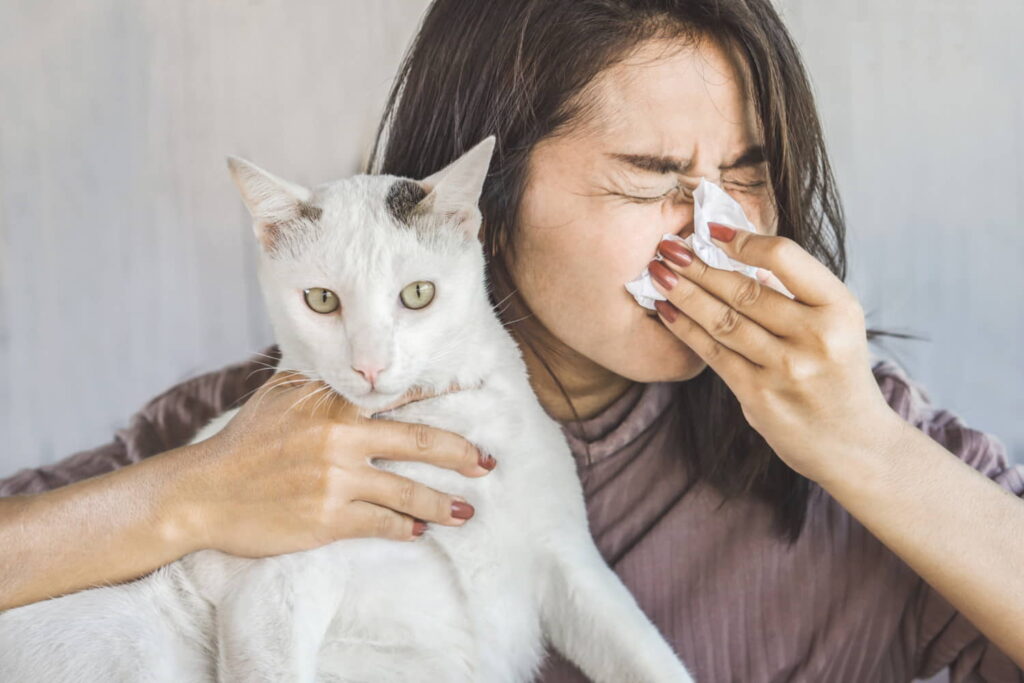Does interacting with your feline companion bring tears of agony instead of tears of joy? In addition to itchy, watery eyes, do you exhibit other symptoms such as runny nose, rash, hives, coughing, sneezing, wheezing, asthma or other breathing problems?

Like an estimated 2 percent of the U.S. population, you suffer from an allergy to cats and, like about one-third of those people, you’ve chosen to keep your cat companion. But at what cost?
Contrary to popular belief, cat hair itself is not allergenic. The cause of allergy to cats is a protein called Fel d 1 emanating from sebum found in the sebaceous glands of cats. The protein attaches itself to dried skin, called dander, that flakes off and floats through the air when cats wash themselves. Although you may never be able to eliminate all your allergy symptoms, following these suggestions can help to cope with cat allergies.

Cat Allergy Treatments & Remedies

- Designate your bedroom as a cat-free zone. Begin your program of allergen reduction by washing bedding, drapes and pillows. Better yet, replace them. Use plastic covers that are designed to prevent allergens from penetrating on your mattress and pillows. Allergen-proof covers are available from medical supply outlets. Don’t expect results overnight. Cat allergens are one-sixth the size of pollens, and it may take months to reduce them significantly.
- Restrict your cat’s access to designated areas inside your home. If you have a safe outdoor enclosure, allow your cat a while outside where dander will waft away in the wind. Brush your cat in the fresh-air enclosure to prevent loose, allergen-carrying hair from dispersing through your home.
- Eliminate allergen traps such as for example upholstered furniture and rugs. Carpet can accumulate up to 100 times the amount of cat allergens as hardwood flooring, so replacing the wall-to-wall with wood will keep allergens from accumulating as much. If ripping up the carpet is not an option, have it steam cleaned as often as needed.
- Vacuuming blows as many allergens through the air as it removes, so when you vacuum, use an allergen-proof vacuum cleaner bag or a vacuum cleaner with a high efficiency particulate arresting (HEPA) filter.
- Get some fresh air. Highly insulated homes trap allergens as well as heat, so open the windows to increase the ventilation in your home, and run window fans on exhaust. (But remember to always screen windows so kitty stays safely indoors.) Also, clean the air flow inside your home. Although nothing will remove all of the allergens present, running an air cleaner with a HEPA filter will help.
- Wipe the dander away. Bathing a cat often is suggested as a way to reduce the dander, but experts disagree on its effectiveness. “Bathing a cat was once believed to be helpful,” say Dr. Robert Zuckerman, an allergy and asthma specialist in Harrisburg, PA, “but the cat would have to be has beenhed almost daily.” Instead, daily use of products such as Pal’s Quick Cleansing Wipes™ will remove saliva and dander from your cat’s hair and are less stressful for felines who prefer not to be rubbed in the tub.
- Spray allergens away. Anti-allergen sprays are a convenient way to deactivate allergens, including those produced by pets. Allersearch ADS, made from plant-based, non-toxic substances, can be sprayed throughout the house to take the sting out of household dust by rendering allergens harmless.
- Clean the cat box. Cat allergen is found in urine and is left in the litter package when your cat makes a deposit. To help prevent allergic reactions to the litter box, use a brand of litter that is less dusty and have someone in the household who will be not allergenic clean the box.
- Take your medicine. Over-the-counter or prescription antihistamines, decongestants, eye drops and aerosol inhalers will help reduce the symptoms, although they do not eliminate the allergy. If you prefer to take a holistic approach, try Nettle tea, a bioflavinoid called quercetin or acupuncture. In recent studies antioxidants such as Vitamins C and E have demonstrated significant anti-allergen effects.
- Get tested. An allergy specialist can determine the exact source of your allergic reactions by a simple prick of the skin on your arm or back.
- Look at the whole picture. Because allergies rarely come individually wrapped, other culprits, such as dust mites and pollen, may be causing reactions, too. “An individual rarely has a single allergy,” says Zuckerman. “A cat owner may be able to tolerate contact with the cat in winter, but when spring arrives, all the allergies together may prove unbearable.”
- Build up resistance. There is no cure for allergy to cats, but immunotherapy may help increase your tolerance. Immunotherapy involves getting allergy shots once or twice weekly for up to six months, then monthly boosters for three to five years. Some individuals develop complete immunity, while others continue to need photos, and still others find no relief at all.

Coping with an allergy to cats is nothing to sneeze at. It’s a commitment. After all, shelters receive cats for this reason every day. Hopefully, following these tips will make a world of difference.
Karen Commings is the author of “Manx Cats” (Barron’s, 1999), “The Shorthaired Cat” and “Shelter Cats” (Howell Book House, 1996 and 1998, respectively).
Wondering about What Is Cat Huffing and Is It Safe? Check it out on our latest post!


0 Comments